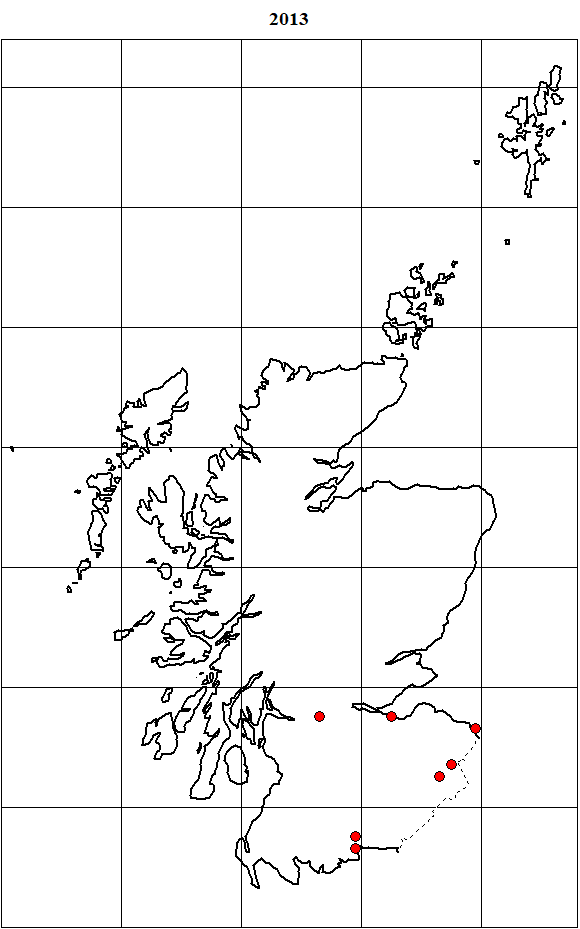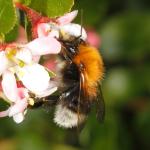Apis aprica FABRICIUS, 1798; Bombus leucopygus ILLIGER, 1806; Apis ericetorum PANZER, 1800-1; Apis meridiana PANZER, 1800-1; Bombus calidus ERICHSON, 1851; Bombus fletcheri RICHARDS, 1934; Bombus insularis SAKAGAMI & ISHIKAWA, 1969, not of SMITH, 1861:155 (= B. insularis (SMITH)); Bombus koropokkrus SAKAGAMI & ISHIKAWA, 1972.
If the story of B. cullumanus is one of decline and gloom, that of B. hypnorum reminds us that changes are not necessarily all one way. This small bumblebee, looking rather like a white-tailed B. pascuorum although actually a member of the B. pratorum-group (Pyrobombus), has been steadily increasing its range throughout Europe. That it should be able to expand, in the face of declines of many other bumblebee species, is due to the fact that this is a species associated with open clearings in woodlands. With the expansion of urban gardens throughout Europe it has been able to find readily available forage and nesting resources.
First recorded in Britain in 2001 from near Southampton. Currently known (2015) from much of England and Wales. The bee was recorded in Scotland for the first time in 2013 (Several places in the Borders and also in the Central Lowland belt) and has been spreading across areas of suitable habitat rapidly. The first records from the island of Ireland came in the Autumn of 2014 when a queen was found visiting Ivy (Hedera helix) flowers on the Antrim coast at Cushenden. It is, as yet unrecorded from Man. There seems little reason why it should not eventually spread to most of Britain. Widely distributed across Europe and Asia to Japan. In 2010 the species appeared in Iceland for the first time (Ólafsson 2010).
The following animted map courtesy of The Highland Biological Recording Group shows up-to-date distribution in Scotland.

This species is not regarded as being of conservation concern in Britain
A unique colour pattern (brown/black/white) makes this bumblebee distinctive. The brown hairs of the thorax may be intermixed with black hairs, and the colour appears darker when this happens. Sometimes, the black hairs predominate and the thorax appears black to the naked eye.
Occasionally, the bee could be confused with faded B. pascuorum, but the snow-white tail of B. hypnorum is always obvious.
As with most other Pyrobombus this is a species closely associated with open woodland conditions. Gardens are basically this and the species is strongly synanthropic in Britain, although this may change as it becomes more established.
Queens emerge from hibernation in late February or March. It appears that this species can have two generations in the year (as do many other Pyrobombus in the south of England). Males have been found in the second half of May and again at the end of August and early September. Late flying queens have been noted in November and even early December.
Nests in aerial cavities, often using old bird nests or nest boxes, but also small mammal nests as starters. The species is commonly associated with human activity and is regularly found nesting under eaves, behind soffit boards and in cavity walls. It also regularly nests low to the ground in compost bins. Løken (1973) notes that B. hypnorum has larger colonies than most Pyrobombus. Von Hagen (1994) suggests there may be up to 400 workers.
Observations in Britain and elsewhere in Europe confirm that this species is broadly polylectic and will visit a very wide range of flowers from many plant families.
No parasites are recorded for this species in Britain, but elsewhere within the wider range of B. hypnorum, the non-British B. norvegicus is a social parasite.
Profile written: 2009
Updated May 2014.
Updated May 2015.
Updated June 2025










